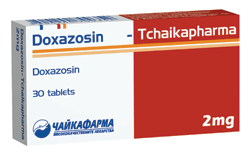- Has post-synaptic alpha blocking and vasodilator properties and rarely causes tachycardia
- Reduce blood pressure rapidly after the first dose and should be introduced with caution
- Can be used with other antihypertensive drugs in the treatment of resistant hypertension
DOXAZOSIN

Indication: hypertension
Dosage:
- Initial: 1 mg/day at bedtime
- Maintenance: 4 mg once daily
- Max: 16 mg/day
Administration: May be taken with or without food
Contraindications: Known hypersensitivity to quinazolines
Special Precautions: Renal or hepatic impairment. Prostatic carcinoma should be ruled out before starting therapy. Orthostatic hypotension may occur at the initiation of therapy or when there is dose increase. Avoid driving or performing hazardous tasks for 24 hr after starting therapy or dose changes. Pregnancy and lactation.
Adverse Drug Reactions: Chest pain, fatigue, headache, influenza-like symptoms, pain, hypotension, palpitation, abdominal pain, diarrhoea, nausea, oedema, dizziness, dry mouth, somnolence, dyspnoea, respiratory disorders, vision abnormalities, impotence, urinary tract infection, increased sweating, anxiety, insomnia. Vertigo, orthostatic hypotension, arrhythmia, hypotension, arthralgia/arthritis, muscle weakness, myalgia, kinetic disorders, ataxia, hypertonia, muscle cramps, flushing, tinnitus, sexual dysfunction, rhinitis, epistaxis, polyuria, urinary incontinence, fatigue/malaise, face oedema.
Drug Interactions: Decreased hypotensive effect with NSAIDs. Increased hypotensive effect with β-blockers, diuretics, ACE inhibitors, calcium-channel blockers.
Pregnancy Category (US FDA): Category C: Either studies in animals have revealed adverse effects on the fetus (teratogenic or embryocidal or other) and there are no controlled studies in women or studies in women and animals are not available. Drugs should be given only if the potential benefit justifies the potential risk to the fetus.
Mechanism of action: Doxazosin competitively blocks the α1-adrenoceptors on postsynaptic effector cells in arteriolar and venous vascular beds resulting in vasodilation of veins and decrease in total peripheral resistance and BP.Onset: 2-6 hr (oral).Duration: 24 hr.Absorption: Well absorbed from the GI tract; peak plasma concentrations after 2 hr (oral).Distribution: Protein-binding: Extensive.Metabolism: Extensively hepatic.Excretion: Faeces (small amounts as unchanged drug and as metabolites); 22 hr (elimination half-life); not removed by dialysis.
ATC Classification: C02CA04 - doxazosin; Belongs to the class of alpha-adrenoreceptor antagonists, peripherally-acting antiadrenergic agents. Used in the treatment of hypertension.
PRAZOSIN

Available brands: Apo-Doxazosin tab Cardura tab Cardura XL controlled release tab Dophilin tab Magurol tab Pencor tab
Available brands: Atodel tab Minipress tab Minison tab Mizosin tab
Indication: hypertension
Dosage:
- Initial: 500 mcg 2-3 times/day for 3-7 days
-increase to 1 mg 2-3 times/day for the next 3-7 days if tolerated
-May further increase if needed.
-Max: 20 mg/day.

Administration: May be taken with or without food. (Starting dose is best taken w/ dinner, at least 2-3 hr before retiring. Maintenance doses may be taken w/ or without meals.)
Contraindications: Congestive heart failure due to mechanical obstruction. Hypersensitivity. Pregnancy.
Special Precautions: Angina pectoris. Ability to drive or operate machinery may be impaired. Phaeochromocytoma, abrupt withdrawal, impaired renal and liver function. child <12 style="font-style: italic;">Adverse Drug Reactions: Postural hypotension, syncope, palpitations, lack of energy, nausea, oedema, chest pain, dyspnoea, constipation, diarrhoea, vomiting, depression, nervousness, sleep disturbances, headache, lassitude, drowsiness, loss of consciousness, dizziness, vertigo, hallucinations, paraesthesia, nasal congestion, epistaxis, dry mouth, urinary frequency and incontinence, pruritus, rash.Potentially Fatal: Rarely, hypotension may be life-threatening.
Drug Interactions: May increase plasma concentrations of digoxin. Antihypertensive effect enhanced by other antihypertensive drugs. Diuretics and alcohol.
Pregnancy Category (US FDA): Category C: Either studies in animals have revealed adverse effects on the fetus (teratogenic or embryocidal or other) and there are no controlled studies in women or studies in women and animals are not available. Drugs should be given only if the potential benefit justifies the potential risk to the fetus.
Mechanism of action: Prazosin competitively blocks postsynaptic α1-adrenoceptors of veins and arterioles causing vasodilation and reduction in blood pressure. The effect is seen in resistant vessels. There is no reflex tachycardia. Diastolic pressure reduced to a greater extent.Absorption: Readily absorbed from the GIT; peak plasma concentrations after 1-3 hr (oral).Distribution: Small amounts enter the breast milk. Protein-binding: High.Metabolism: Extensively hepatic.Excretion: Faeces (5-11% as unchanged drug; metabolites); urine (<10%); style="font-style: italic;">ATC Classification: C02CA01 - prazosin; Belongs to the class of alpha-adrenoreceptor antagonists, peripherally-acting antiadrenergic agents. Used in the treatment of hypertension.
TRAZOSIN
Available brands: Hytrin tab Ralsin tab Terasin tab
Indication: hypertension
Dosage:
-Initial: 1 mg at bedtime, gradually increase if needed
-Maintenance: 2-10 mg once daily
-Max: 20 mg/day in 1-2 divided doses.
Administration: May be taken with or without food.
Contraindications: Hypersensitivity to quinazoline derivatives.
Special Precautions: Elderly. Syncope and orthostatic associated with first dose phenomenon. Pregnancy and lactation.
Adverse Drug Reactions: Orthostatic hypotension, syncope, dizziness, fatigue, somnolence, peripheral oedema, headache, nasal congestion, nausea, blurred vision, postural hypotension, palpitations, priapism.
Drug Interactions: Decreased antihypertensive effect with NSAIDs. Orthostatic hypotension potentiated by other antihypertensive agents.
Pregnancy Category (US FDA): Category C: Either studies in animals have revealed adverse effects on the fetus (teratogenic or embryocidal or other) and there are no controlled studies in women or studies in women and animals are not available. Drugs should be given only if the potential benefit justifies the potential risk to the fetus.
Mechanism of action: Terazosin is an α1-adrenoceptor antagonist with a longer duration of action than prazosin. It blocks peripheral postsynaptic receptors resulting to decreased arterial tone. It relaxes smooth muscle of the bladder neck causing a reduction of bladder outlet obstruction. It reduces BP with minimal effect on heart rate. In the prostate, terazosin reduces the vascular tone which is the dynamic component in benign prostatic enlargement. Terazosin can increase urinary flow rates in patients with benign prostatic hyperplasia (BPH).Onset: 15 min.Duration: 24 hr.Absorption: Rapid and almost complete from the GI tract; bioavailability 90%; peak plasma concentrations after 1 hr (oral).Distribution: Protein-binding: 90-94%Metabolism: Hepatic.Excretion: Faeces and urine (as unchanged drug and metabolites); 12 hr (elimination half-life).
ATC Classification: G04CA03 - terazosin; Belongs to the class of alpha-adrenoreceptor antagonists. Used in the treatment of benign prostatic hypertrophy.
Tuesday, January 12, 2010
ALPHA-ADRENOCEPTOR BLOCKING DRUGS
Posted by sitirx8 at 8:47 AM
Subscribe to:
Post Comments (Atom)

0 comments:
Post a Comment